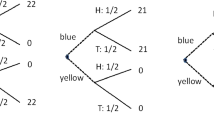Abstract
This paper takes the Anscombe–Aumann framework with horse and roulette lotteries, and applies the Savage axioms to the horse lotteries and the von Neumann–Morgenstern axioms to the roulette lotteries. The resulting representation of preferences yields a subjective probability measure over states and two utility functions, one governing risk attitudes and one governing ambiguity attitudes. The model is able to accommodate the Ellsberg paradox and preferences for reductions in ambiguity.
Similar content being viewed by others
Notes
A degenerate lottery places probability one on a single outcome.
The sum in the Anscombe–Aumann representation reflects the fact that their state space is finite, and replaces the integral in Eq. 2.
Anscombe and Aumann’s original approach, however, only allows for a finite state space. Consequently, the axioms in Section 1, combined with an ambiguity-neutrality axiom, would comprise an infinite state space version of the Anscombe–Aumann model.
This simplicity has a cost, though, as the approach implicitly identifies as ambiguous anything other than a constant horse lottery, or put differently, anything that generates a subjective belief. While this is consistent with Strzalecki (2009), it runs contrary to preference-based attempts to define “ambiguous,” such as in Epstein and Zhang (2001), Ghirardato et al. (2004), and Ahn (2008).
Grandmont’s Archimedean axiom A8 could be replaced by the more standard continuity axiom if attention were restricted to horse lotteries that generate simple roulette lotteries in each state, that is, probability distributions with finite support. Doing so would require altering expression (4) to replace the inner integral with a sum.
The probability measure μ is convex-ranged if for any event E, for every \(\alpha \in \lbrack 0, \mu (E)]\) there exists an event \(E^{\prime } \subseteq E\) for which μ(E ′) = αμ(E).
Alternatively, one could specify a single, joint distrubution over the two state variables. Since they would be statistically independent, though, they can be treated separately.
References
Ahn, D. S. (2008). Ambiguity without a state space. Review of Economic Studies, 75(1), 3–28.
Anscombe, F. J., & Aumann, R. J. (1963). A definition of subjective probability. Annals of Mathematical Statistics, 34(1), 199–205.
Chew, S. H., & Sagi, J. S. (2008). Small worlds: Modeling attitudes toward sources of uncertainty. Journal of Economic Theory, 139(1), 1–24.
Ellsberg, D. (1961). Risk, ambiguity, and the Savage axioms. Quarterly Journal of Economics, 75(4), 643–669.
Epstein, L. G., & Zhang, J. (2001). Probabilities on subjectively unambiguous events. Econometrica, 69(2), 265–306.
Ergin, H., & Gul, F. (2009). A subjective theory of compound lotteries. Journal of Economic Theory, 144(3), 899–929.
Ghirardato, P., Maccheroni, F., & Marinacci, M. (2004). Differentiating ambiguity and ambiguity attitude. Journal of Economic Theory, 118(2), 133–173.
Gilboa, I. (1987). Subjective utility with purely subjective non-additive probabilities. Journal of Mathematical Economics, 16(1), 65–88.
Gilboa, I., & Schmeidler, D. (1989). Maxmin expected utility with a non-unique prior. Journal of Mathematical Economics, 18(2), 141–153.
Gilboa, I., Maccheroni, F., Marinacci, M., & Schmeidler, D. (2010). Objective and subjective rationality in a multiple prior model. Econometrica, 78(2), 755–770.
Grandmont, J.-M. (1972). Continuity properties of a von Neumann–Morgenstern utility. Journal of Economic Theory, 4(1), 45–57.
Grant, S., Polak, B., & Strzalecki, T. (2009). Second-order expected utility. Mimeo.
Hazen, G. B. (1987). Subjectively weighted linear utility. Theory and Decision, 23(3), 261–282.
Hazen, G. B., & Lee, J. S. (1991). Ambiguity aversion in the small and in the large for weighted linear utility. Journal of Risk and Uncertainty, 4(2), 177–212.
Klibanoff, P., Marinacci, M., & Mukerji, S. (2005). A smooth model of decision making under ambiguity. Econometrica, 73(6), 1849–1892.
Kreps, D. M., & Porteus, E. L. (1978). Temporal resolution of uncertainty and dynamic choice theory. Econometrica, 46(1), 185–200.
Maccheroni, F., Marinacci, M., & Rustichini, A. (2006). Ambiguity aversion, robustness, and the variational representation of preferences. Econometrica, 74(6), 1447–1498.
Nau, R. F. (2006). Uncertainty aversion with second-order utilities and probabilities. Management Science, 52(1), 136–145.
Neilson, W. S. (1993). Ambiguity aversion: An axiomatic approach using second-order probabilities. Mimeo.
Sarin, R. K., & Wakker, P. (1992). A simple axiomatization of nonadditive expected utility. Econometrica, 60(6), 1255–1272.
Savage, L. J. (1954). Foundations of statistics. New York: Wiley.
Schmeidler, D. (1989). Subjective probability and expected utility without additivity. Econometrica, 57(3), 571–587.
Strzalecki, T. (2009). Axiomatic foundations of multiplier preferences. Mimeo.
von Neumann, J., & Morgenstern, O. (1944). Theory of games and economic behavior. Princeton: Princeton University Press.
Werner, J. (2005). A simple axiomatization of risk-averse expected utility. Economics Letters, 88(1), 73–77.
Acknowledgements
I am grateful to Kip Viscusi and a referee for helpful comments, and especially to Peter Klibanoff for both encouragement and comments.
Author information
Authors and Affiliations
Corresponding author
Rights and permissions
About this article
Cite this article
Neilson, W.S. A simplified axiomatic approach to ambiguity aversion. J Risk Uncertain 41, 113–124 (2010). https://doi.org/10.1007/s11166-010-9099-4
Published:
Issue Date:
DOI: https://doi.org/10.1007/s11166-010-9099-4




